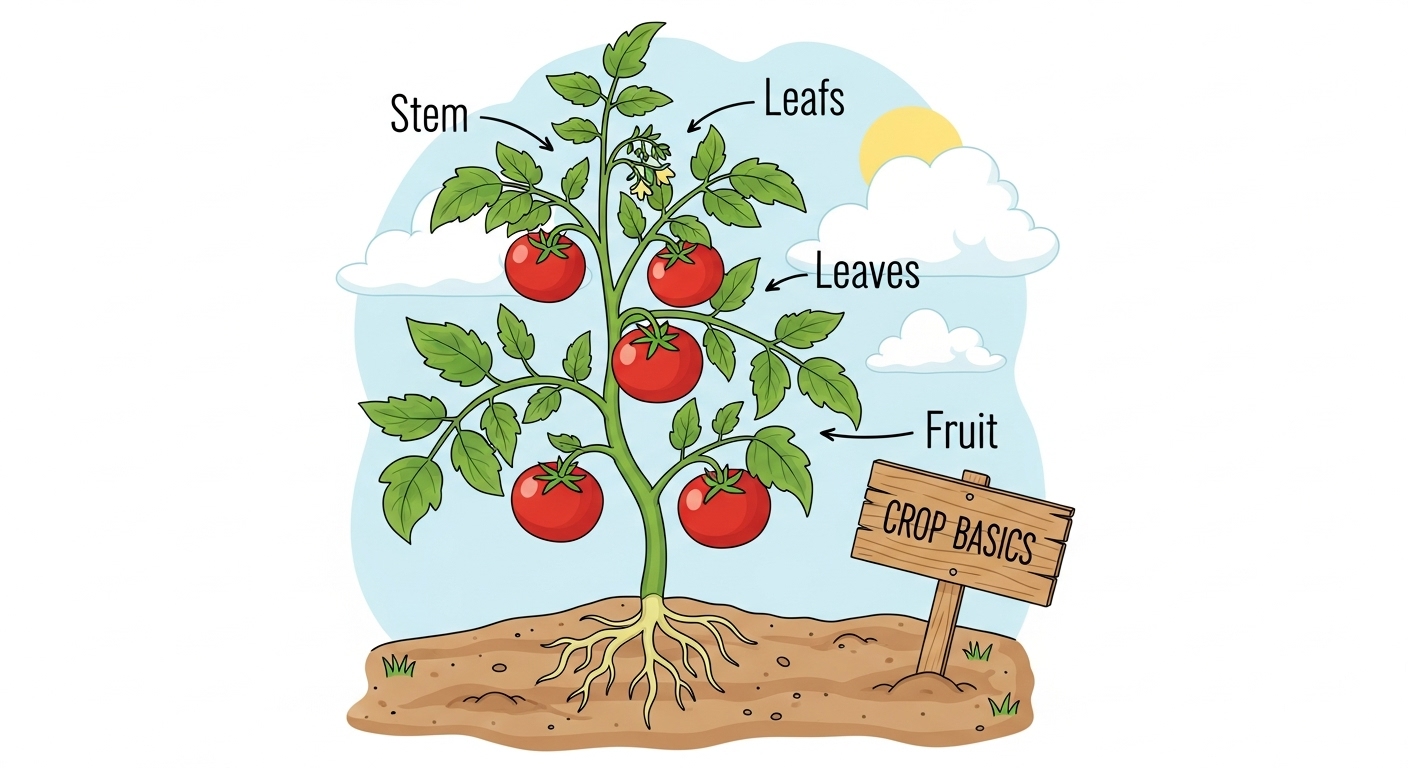The tomato, scientifically known as Solanum lycopersicum, is one of the most widely cultivated and consumed crops across the globe, particularly in India, which stands as the world’s second-largest tomato producer.
Understanding the basic characteristics and classifications of tomato crops is essential for both home gardeners and commercial farmers who want to maximize their cultivation success.
Botanical Classification and Scientific Identity
Tomatoes belong to the nightshade family (Solanaceae), which also includes important crops like potatoes, peppers, and eggplants. The complete botanical classification reveals the tomato’s plant identity:
- Kingdom: Plantae
- Family: Solanaceae
- Genus: Solanum
- Species: Solanum lycopersicum
Historically, tomatoes were also known by the scientific name Lycopersicon esculentum, though modern botanical classification has settled on Solanum lycopersicum.
The plant originated in the Andes Mountains of South America, particularly in Peru and Ecuador, before being domesticated in pre-Columbian Mexico.
Plant Type and Growing Characteristics
Tomatoes are tender perennials that are typically grown as annuals in most climates. This means that while the plant has the biological capacity to live for multiple years in frost-free environments, most farmers and gardeners cultivate them as single-season crops due to temperature limitations.
The physical characteristics of tomato plants include:
- Height: Ranges from 1 to 10 feet (30cm-3m) depending on variety
- Growth habit: Sprawling, vine-like plants with weak, woody stems
- Leaves: Pinnately compound leaves that are 4–18 inches long with serrated edges
- Flowers: Small yellow flowers (about 1-2 cm across) that appear in clusters of 3-12
The Fruit vs. Vegetable Classification
One of the most common questions about tomatoes involves their classification as either a fruit or vegetable. Botanically, tomatoes are definitively fruits because they develop from flowers and contain seeds.
However, culinarily, they are treated as vegetables due to their savory flavor profile and use in main dishes rather than desserts.
This dual classification was even legally settled by the U.S. Supreme Court in 1893, which ruled that tomatoes should be considered vegetables for trade and tariff purposes based on their culinary applications.
The confusion arises because while tomatoes meet the botanical definition of fruit (seed-bearing structures that develop from flower ovaries), they lack the sweet taste typically associated with culinary fruits.
Growth Types and Varieties
Tomato plants are primarily classified into two main growth types that significantly impact cultivation practices:
Determinate Varieties
Determinate tomatoes are compact, bush-type plants that:
- Grow to a predetermined height (typically 2–4 feet)
- Produce flowers at terminal buds, stopping further growth
- Ripen most of their fruit within 4–6 weeks
- Are ideal for canning and processing
- Require minimal staking support
Indeterminate Varieties
Indeterminate tomatoes are vine-type plants that:
- Continue growing until killed by frost
- Can reach heights of 6-10 feet or more
- Produce fruit continuously throughout the growing season
- Require substantial staking and pruning
- Are better suited for fresh market production
Cultivation Requirements and Growing Seasons
Tomatoes require warm growing conditions, with temperatures between 15-30°C (59-86°F) for optimal growth. The crop needs:
- Temperature: Optimal range of 21-28°C during the day
- Sunlight: At least 6–8 hours of direct sunlight daily
- Soil: Well-draining, slightly acidic soil (pH 5.8-6.8)
- Water: Consistent moisture without waterlogging
In India, tomatoes can be grown year-round with three distinct seasons:
- Northern Plains: Kharif (June-July), Rabi (October-November), and Zaid (February-March)
- Southern States: June-July, October-November, and January-February planting cycles
Crop Duration and Maturity
The complete tomato crop cycle typically spans 100–120 days from seed to harvest, though this varies significantly based on variety and growing conditions. The growth stages include:
- Germination: 5–10 days
- Seedling stage: 15–25 days
- Vegetative growth: 20–30 days
- Flowering: 2–3 weeks (begins 45–60 days after transplanting)
- Fruit development: 20–30 days
- Ripening: 15–20 days
For those interested in understanding the complete timeline and management practices for each growth stage, detailed information about Tomato Crop Duration in India: Key Growth Stages provides comprehensive insights into optimizing cultivation practices throughout the growing season.
Economic and Agricultural Importance
Tomatoes represent one of India’s most valuable horticultural crops, with the country producing over 20 million tonnes annually.
The crop offers excellent economic returns with benefit-cost ratios ranging from 1.29 to 2.50, making it attractive for both small-scale and commercial farmers.
Average yields vary significantly:
- Open field cultivation: 20–25 tonnes per hectare
- Hybrid varieties: 50–60 tonnes per hectare under optimal conditions
- Protected cultivation: Even higher yields possible
Modern Varieties and Market Classes
Contemporary tomato cultivation recognizes several major market categories:
- Standard/Slicing tomatoes: Medium to large fruits for fresh consumption
- Beefsteak tomatoes: Large fruits (often exceeding 1 pound) with dense flesh
- Cherry tomatoes: Small, bite-sized fruits (less than 30g) for snacking
- Paste tomatoes: Thick-fleshed varieties with high solids content for processing
- Salad tomatoes: Medium-sized varieties ideal for fresh preparations
Understanding these basic characteristics of tomato crops – from their botanical identity to growth requirements and market classifications – provides the foundation for successful cultivation.
Whether you’re planning a small home garden or commercial production, recognizing tomatoes as warm-season, fruit-bearing plants of the nightshade family helps inform proper variety selection, timing, and management practices for optimal yields and quality.

